|
Outline - Electric Fields
|
|
- Difference between Action-at-a-Distance and Field Approach
- Action-at-a-Distance (Fig. 1a)

- Assume one charge acts through a distance to exert
a force on another charge.
- The force F21 of q2 on q1
is equal in magnitude to
the force F12 of q1 on q2,
but is opposite in direction.
Fe = F21 = F12 = q1q2/4peor2
= kq1q2/r2,
where 1/4peo
= k = 9.0 x 109 N-m2/C2.
- In the electric field approach (Fig. 1b below), the electric
field associated with a charged object permeates all of space.
It is then the electric field that exerts a force on another
charge placed in this field. The electric field at a point
P equals the electric force Fe on a positive
point charge qo divided by qo. The direction
of the electric field is that in which a positive test charge
is urged.
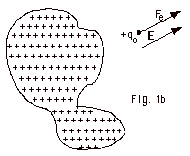
- Finding Electric Fields
- In general the electric field E = Electric force Fe
on qo divided by qo.
For the special case of an electric field due to a point charge
+Q
at a distance r from +Q =
E = (Fe on qo)/qo
= (kQqo/r2)/qo = kQ/r2.
Notice the electric field at P depends on the charge Q that
sets up the field and the distance of P from Q, but it does
not depend on the test charge.
See Fig. 2a below.
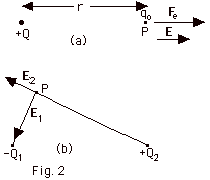
If the electric field is due to more than one charge (Fig.
2b above), find the electric field at P due to each charge.
The resultant field equals the vector sum of the fields due
to each individual charge (Fig. 2b above).
Sample
Problem: In Fig. 3, q1
= -1.0 x 10-6 C and q2= +3.0 x 10-6
C.
Find the electric field at point P in Fig. 3a below.

Solution
to Sample Problem: The electric field due to
a point charge q = kq/r2, where q is the charge
setting up the field and r is the distance of the point P
at which you wish to find the field from q. The direction
of the electric field is that in which a positive test charge
+qo is urged. Think of the charges setting up the
field as set in concrete. You are not interested in a force
between the charges and what happens to these charges when
you are finding the field due to them.
The electric field due to q1=
| E1 =
(9.0 x 109 N-m2/C2)(1.0
x 10-6 C)/(3.0 m)2 = 1.0 x 103
N/C. |
Do not put in the minus sign for the charge. Look at the figure
and imagine a positive test charge qo at P. q1
would attract the positive test charge, so E1
is to the right.
The electric field due to q2 =
|
E2 = (9.0 x 109
N-m2/C2)(3.0 x 10-6
C)/(6.0 m)2 = 0.75 x 103 N/C.
|
q2 would repel the positive test charge, so E2
is to the left. The field due to both charges E = (1.0 - 0.75)103
N/C = 0.25 x 103 N/C to the right.
- When you have a "continuous" distribution of
charge, you may think of the total charge as made up of elements
of charge dq. For a line of charge, it is useful to
define l =
charge/length. Then the charge element dq = l(element
of length). For a line of charge, take the element of length
= dx. Then dq = ldx.
If the distribution of charge is along an arc, the
element of length is ds and ds = R dQ with
dq = lRdQ.
Sample
Problem: In Fig. 4 below, there are three nonconducting
rods, one circular and two straight. Each has a uniform charge
of magnitude Q along its top half and along its bottom half.
Find the direction of the resultant electric field at point
P for each of the rods.

Solution
of Sample Problem: For each case I took distributions
of charge that were symmetrically distributed about the center
of the rod. I also took equal quantities of charge dq. At
point P in Fig. 4a, the electric fields due to a negative
and positive element of charge dq are as shown in the Solution
Figure below:

Remember that the direction of an electric field is the direction
in which a positive test charge is urged. At P, the
-dq on the upper arc of the rod would urge the test charge
toward it, while the +dq on the lower arc would urge the test
charge away from it. Notice that the components of dE+
and dE- in the X-direction
cancel. Since this is true for all of the symmetrically disposed
elements, the resultant field is in the +Y-direction. In (b)
the +dq symmetrically disposed elements (the distance
r from each element is the same) urge a positive test charge
away from them. Since this is true for all of the symmetrically
disposed elements, the components in the Y-direction cancel
and the resultant electric field is in the +X-direction. By
similar reasoning you can see that the resultant electric
field in (c) is in the - Y-direction.
- Additional sample problems are found in 106
Problem Set for Electric Fields: 1 - 5, 7, and
8.
- Electric Flux FE
Definition: 
where  E,
dA equals the angle between E and dA. dA
is an element of area. E,
dA equals the angle between E and dA. dA
is an element of area.
The direction of dA is that of the outward normal to the
surface.

- Gauss's Theorem

- FE is the
total flux crossing a three dimensional surface
 is
the integral around a closed three dimensional surface is
the integral around a closed three dimensional surface
- Application
Choose Gaussian surface that gives maximum symmetry properties
such that:
- E is normal to the surface, that is, the angle
between E and dA
is zero, and E . dA = E dA cos
0o = E dA
- E is constant everywhere on the surface, that is,

- Examples
Spherically symmetrical distribution of charge (Fig. 6 below):
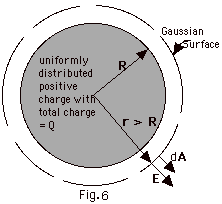
- For hypothetical Gaussian surfaces (shown by dashed
cross-section of spheres in Fig. 6) choose sphere.
- E must be normal to surface and constant at any
point on a Gaussian surface or the symmetry of a sphere
would be unraveled by rotating it.
- For r > R or r < R,
 E,
dA must be zero and E is constant everywhere
on the Gaussian surface. E,
dA must be zero and E is constant everywhere
on the Gaussian surface.


- For r ≥ R, E(4pr2)
= Q/eo
or E = Q/4peor2
- For r ≥ R, all the charge acts as though
it were a point charge at the center of the sphere.
- Electric fields due to other special cases
- Electric field due to an infinite plane = 2pkq/A
= s/2eo,
where q is the charge on the plate, A the
area of the plate, s
the charge per unit area = q/A, k = 9.0 x 109
N-m2/C2, and 1/e0
= 4pk.
- Electric field between two oppositely charged plates = 4pkq/A
= s/e0.
- Electric field due to long line of charge or outside a cylinder
of charge is l/2peor
= 2kl/r where
l= charge per unit length
= q/L.
- Electric field due to a conducting sphere with radius R
and charge Q outside of the sphere is Q/4peor2
= kQ/r2.
- Electric Field inside a Conductor
- A conductor is defined as a material in which electrons
are free to move. They move until there is no electric field
inside the conductor.
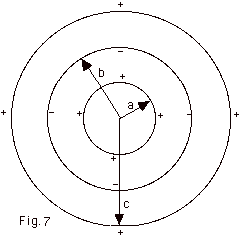
- Figure 7 above represents a conducting sphere of radius
a coaxial with a conducting spherical shell of inner radius
b and outer radius c.
- If positive charge q is placed inside the sphere, electrons
move in such a way to make the electric field inside the
sphere equal to zero and the positive charge +q on the
outside of the conducting sphere.
- Electrons from the spherical conducting shell are drawn
towards the positive charge on the sphere, leaving the
inner surface of the shell with a negative charge -q,
the outer surface of the conducting spherical shell positively
charge +q and no electric field inside the conducting
shell.
- Sample problems in 106
Problem Set for Electric Fields: 9, and 11-15.
- Electric Field of a Dipole
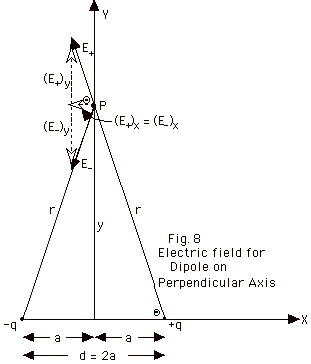
- Description
- Dipole consists of two point charges of opposite sign,
but equivalent quantity of charge.
- The charges are separated by a distance d = 2a in Fig.
8 above.
- We are often interested in cases for which the distance
from the center of the dipole to the point P where we
wish to find the electric field is much greater than d
the distance of separation of the charges.
- Calculation of E for point on perpendicular bisector (Fig.
8 above)
- At P, the electric field due to the positive
charge is
E+ = kq/r2 = kq/(a2
+ y2)
upward along the line connecting P with
+q.
- At P, the electric field due to the negative
charge is
E- = kq/r2
= kq/(a2 + y2)
downward along the line connecting P with
- q.
- Notice that the magnitudes of the field due to +q and
- q are equal.
In Fig. 8, we see the Y-components of the electric field
due to +q and the electric field due to - q, (E+)y
and (E-)y
, respectively, cancel.
- The components of the electric field in the X-direction,
(E+)x = E+ cos Q
and (E-)x
= E- cos Q
are equal because E+ = E-.
These components are in the same direction so they add.
The total electric field at P due to both charges E =
2[kq/(a2 + y2)] cos Q.
From the figure, we see that cos Q
= a/(a2 + y2)1/2,
so E = k(2qa)/(a2 + y2)3/2.
- For y >> a, E = k(2qa)/y3 = k(qd)/y3
= kp/y3, where p is called the dipole moment.
We can make p a vector quantity by taking its direction
from the minus charge to the positive charge. The direction
of the electric field in Fig. 8 is in the negative X-direction,
so we may write for y >> a, E = - kpi/y3.
- Calculation for electric field on axis of dipole (Fig.
9 below)
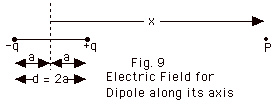
- Electric field at P due to - q is kq/(x + a)2
to the left.
- Electric field at P due to +q is kq/(x - a)2
to the right.
- Taking to the right to be positive, the total electric
field at P due to both charges is
E = kq[1/(x - a)2 - 1/(x + a)2]
= kq{(x + a)2 - (x - a)2}/(x2
- a2)2
= kq{x2 +2ax + a2
- x2 +2ax - a2}}/(x2
- a2)2
= k4aqx/(x2 - a2)2
= 2kpx/(x2 - a2)2.
For x >> a, E = 2kp/x3 and
E = 2kpi/x3.
Again for great distances, E is inversely proportional
to the cube of the distance from the center of the dipole.
- Sample problem in 106
Problem Set for Electric Fields:
23
- Force on a charged particle in a known electric field E.
- Once you know the electric field at a point you can find
the force on a charged particle q placed at that
point. The electric force equals the charge times the electric
field. If the charge is positive, the force is in the direction
of the electric field and we may write F = qE.
If the charge is negative, the force is in the opposite
direction to the field.
- Sample problems in 106
Problem Set for Electric Fields, 17-22.
- Torque on a dipole in an Electric Field
- Dipole moment p = qd. The direction of p is from
the minus charge to the plus charge.
- In a constant electric field, the force on the positive
charge F+ = qE to the right and the force on the
negative charge F- = qE to the left.
(See Fig. 10 below).
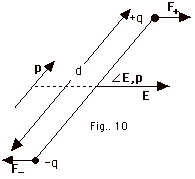
- The torque due to F+ about an axis
through a point half way between the charges is (qEd/2) sin
 E,
p into the page. The torque due to F-
is also (qEd/2) sin E,
p into the page. The torque due to F-
is also (qEd/2) sin  E,
p into the page. E,
p into the page.
The total torque = (qd)E sin  E,
p into the page. A convenient way of writing
the torque is t
= p x E. E,
p into the page. A convenient way of writing
the torque is t
= p x E.
- Sample problem in 106
Problem Set for Electric Fields: 24.
|
|